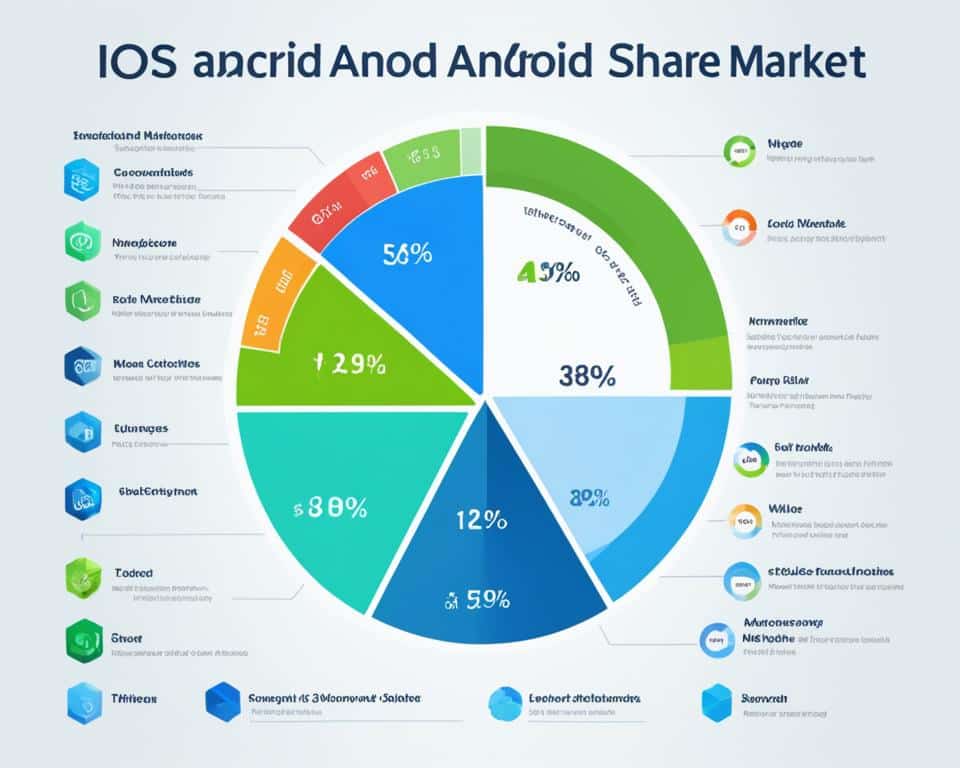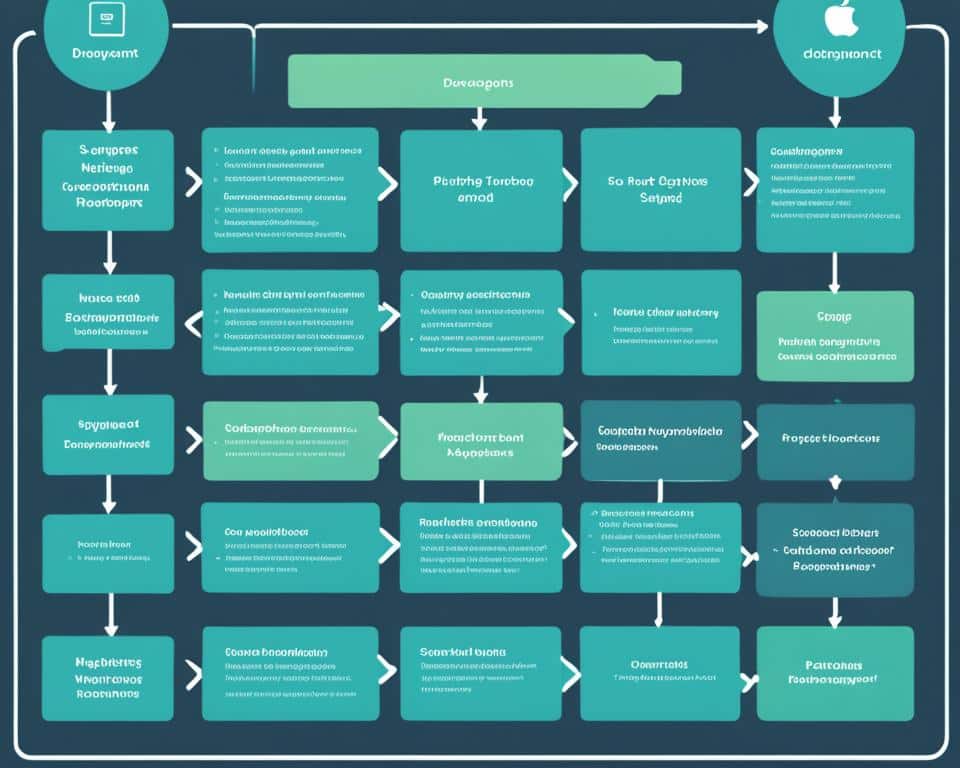The world of mobile tech is always changing, making high-quality, feature-packed apps more important than ever. Users want smooth and easy experiences, making it crucial to focus on native app development for iOS and Android. This guide will take you through the basics of creating apps for these platforms, covering their unique features and the steps to make them.
The article stresses the need for strong mobile app development to satisfy users in the expanding app market. It shows how to build a successful app, from coming up with unique ideas to using analytics and picking how to make money. It also talks about important metrics and tools to track how well an app is doing.
Table of Contents
Key Takeaways
- Learn about the main features and benefits of native app development for iOS and Android.
- Find out how to pick the best platform for your audience and project needs.
- See the full process of native app development, from planning to testing and improving.
- Discover the key tools, frameworks, and design rules for making top-notch native apps.
- Get tips on storing data, integrating with other services, and submitting to app stores.
What is Native App Development?
Native app development means making apps for just one operating system, like iOS or Android. These apps use the special languages, tools, and frameworks of each platform. It’s important for developers and businesses to know about native app development to make great mobile apps.
Definition and Key Characteristics
Native apps are made with the official languages and tools of the platform makers. For iOS, Swift and Objective-C are used. For Android, it’s Kotlin and Java. These apps work well with the device’s hardware and look good on the screen, giving users a great experience.
Some main features of native apps are:
- Great native app performance because they use the device’s hardware directly
- Easy-to-use interfaces that follow the platform’s style
- Use of device features like GPS, camera, and push notifications
- Apps load fast and work smoothly, better than web or hybrid apps
- They are more secure and reliable, being from the official channels
Benefits of Native Apps
Native apps are popular for their speed, reliability, and making users happy. They are great for businesses and developers wanting top-notch mobile apps.
Here are the main benefits:
- Super fast and responsive native app performance
- Work well with device hardware for a better experience
- Can use special features and APIs for richer apps
- More secure and stable, checked by the platform providers
- Keep users coming back with a polished interface
Knowing about native app development helps businesses and developers choose the right way for their apps. This leads to amazing native app user experiences that grab attention in the busy app world.

Choosing the Right Platform: iOS or Android?
Starting to make a native app means deciding between iOS or Android. This choice affects your app’s reach, how users experience it, and the resources you’ll need. By looking at what makes each platform different, you can pick the best one for your app and its users.
Think about who you want to reach with your app. iOS users often have more money and are more likely to buy things in the app. On the other hand, Android has a huge user base, especially in new markets, offering a wider audience.
| Feature | iOS | Android |
|---|---|---|
| Market Share | 15.2% | 84.8% |
| Device Compatibility | Focused on a few device models | Fragmented across a wide range of devices |
| Development Resources | Relatively fewer developers, but higher salaries | More developers available, but lower salaries |
Device compatibility is also key. iOS devices are more uniform, making it easier to keep your app running smoothly across them. Android, however, has more variety, which means you need to think about different screen sizes and hardware.
Choosing between iOS and Android should be based on a deep understanding of your target audience and what each platform offers. By looking at the pros and cons of each, you can make a choice that will help your app succeed.

The Native Mobile App Development for iOS and Android Lifecycle
Creating a successful native app takes a clear plan from start to finish. It covers planning, design, and testing. This guide will walk you through the steps of making a native app. It highlights the need for focusing on users, using agile methods, and careful planning. This ensures your app meets your audience’s needs and expectations.
Planning and Requirements Gathering
The first step in making a native app is planning and gathering requirements. This is key to knowing what your app should do, who will use it, and what they expect. You’ll do market research, understand user needs, and outline the app’s features and technical needs.
By focusing on the user, you make sure your app solves their problems and meets their likes. This increases your app’s chance of success.
Design and Prototyping
After planning, it’s time for design and prototyping. This phase turns ideas into a design that looks good and is easy to use. Using a design that puts users first, you create wireframes, mockups, and prototypes. These let you get feedback and improve your design.
Agile development helps you quickly adapt to what users like and make changes. This way, your app meets technical needs and offers a smooth, engaging experience. This approach to app development is key to a successful and impactful app.

Native App Development Tools and Frameworks
The success of native app development relies a lot on the tools and frameworks chosen. This section looks at the main development environments and programming languages for iOS and Android.
iOS Development with Swift and Xcode
For iOS apps, Apple’s Swift and Xcode are top choices. Swift, launched in 2014, is a modern language that’s fast and safe. It’s now the top pick for iOS developers. Xcode is a suite of tools that makes development easier, from coding to deploying apps.
- Swift: A powerful language that works well with Apple’s platforms and frameworks, like UIKit and Foundation.
- Xcode: A comprehensive IDE for writing code, designing interfaces, testing, and submitting apps to the App Store.
Android Development with Kotlin and Android Studio
For Android, Kotlin and Android Studio are key tools. Kotlin, a modern language, was backed by Google in 2017 and has become popular among Android developers. Android Studio is Google’s official IDE for Android apps. It has many tools to make development smoother.
- Kotlin: A language that works with Java and has a concise syntax, fitting well with the Android ecosystem.
- Android Studio: A full development environment for coding, testing, and deploying Android apps, designed for a smooth user experience.
| Feature | iOS Development | Android Development |
|---|---|---|
| Programming Language | Swift | Kotlin |
| Development Environment | Xcode | Android Studio |
| Native App Frameworks | UIKit, Foundation | Android SDK, Jetpack |
Knowing about these native app development tools and frameworks helps you choose the right ones for your project, whether it’s for iOS or Android.
User Interface Design for Native Apps
Making a great user interface (UI) is key for a native app’s success. By knowing how to follow design rules for iOS and Android, developers can make apps that look good and work well.
iOS Design Guidelines
The iOS Human Interface Guidelines focus on simplicity, making things easy to use, and being consistent. They suggest making interfaces that look good and put the user first. Following these rules helps make apps that feel right at home on Apple devices and are easy for iOS users to use.
Android Design Principles
Android’s design principles aim to make apps look good and easy to use. They use bold colors, clear text, and animations to help users find their way around the app. By matching their apps with these principles, developers can make sure their apps look and feel right on Android devices.
Great user experience is crucial for any native app’s success. By following the design rules for each platform, developers can make apps that are both useful and enjoyable to use.
Data Storage and Management
Storing and managing data well is key for native apps to work great. Apps for iOS and Android have many ways to handle user data. This includes both local and cloud-based options.
For storing data locally, SQLite, Core Data for iOS, and Room for Android are top picks. These databases let apps keep and get data safely on the device. This means quick access and working offline. Cloud-based options like Firebase offer server-side solutions. They sync data across devices and update in real-time.
When picking a data storage method for your app, think about what you need. Consider the app’s data needs, if it should work offline, and how secure and scalable you want it to be. The right choice ensures your app can safely and reliably manage user data, giving users a great experience.
| Data Storage Option | Platform | Key Features |
|---|---|---|
| SQLite | iOS, Android | Lightweight, embedded database for local data storage |
| Core Data | iOS | Powerful framework for managing app data, including local storage and sync |
| Room | Android | Abstraction layer over SQLite, providing a more developer-friendly API |
| Firebase | iOS, Android | Scalable, cloud-based data storage and sync solution with real-time updates |
“Choosing the right data storage solution is crucial for the long-term success and performance of your native app.”
Integrating Third-Party Services and APIs
Native apps often need to work with third-party services and APIs to get better. This helps make the app more useful and fun for users. We’ll look at how to add secure login, make sure users can only do what they should, and send them updates.
Authentication and Authorization
It’s key to have strong security for your app to keep users safe and trusting. Using APIs and other services, you can offer safe ways to log in, like through social media or your phone’s fingerprint scanner. This makes using your app easy and safe for users. It also keeps their personal info and your app’s data safe.
Push Notifications
Push notifications are great for keeping users interested in your app. By adding push notification services, you can send updates and special messages right to your users. This helps keep them up-to-date and connected with what your app offers. Using push notifications smartly can really help your app stand out and build stronger ties with your users.
“Integrating third-party services and APIs can transform your native app, empowering users with secure access and engaging experiences.”
Whether you’re making an app for iOS or Android, getting good at adding secure login, making sure users can only do what they should, and sending updates is key. It makes your app better and gives users a great experience.
Testing and Debugging Native Apps
Ensuring native apps are top-notch is key to their success. This part talks about the must-do testing and debugging methods for developers. These steps help make sure native apps are bug-free and work well.
Unit Testing
Unit testing is a core part of testing native apps. It involves checking each part of the app on its own. This way, developers can spot and fix problems early. It makes sure each part of the app works right, which helps the whole app run smoothly.
Integration Testing
Integration testing checks how different parts of the app work together. It makes sure everything fits well and works as one. This phase is key for a smooth user experience and checking if the app’s features work together right.
UI Testing
UI testing looks at the app’s look and how easy it is to use. Tools for automated UI testing can mimic user actions. They check if the app responds fast and find any UI problems. This helps make the app’s interface better and improve the user experience.
Using a detailed testing plan that includes unit testing, integration testing, and UI testing helps developers. It makes sure the native app testing, automated testing, and debugging are done well. This leads to a quality assurance native app that meets what users expect.
“Rigorous testing is the key to delivering reliable and high-performing native apps.”
App Store Submission and Distribution
After making a native app, you’re not done yet. You need to submit and distribute it through app stores to reach your audience. This part talks about the key rules and review steps for the Apple App Store and the Google Play Store.
Apple App Store Guidelines
Getting your app on the Apple App Store means knowing their strict rules. You must follow design standards and use strong security. The review can be tough, but if you follow the rules, you might get your app on the App Store.
Google Play Store Guidelines
For the Google Play Store, there are different rules. The review is not as hard as the App Store‘s, but your app must still meet Google’s standards. Make sure you know the latest Play Store rules for easy app distribution.
| App Store Submission Criteria | Apple App Store | Google Play Store |
|---|---|---|
| Design Guidelines | Strict adherence to iOS design principles | Flexible design guidelines with Material Design as a recommendation |
| Security and Privacy | Robust security measures and comprehensive user privacy policies | Emphasis on user privacy and data protection |
| Technical Specifications | Detailed requirements for device compatibility, file sizes, and app performance | Flexible technical guidelines with a focus on user experience and app stability |
| Review Process | Comprehensive and rigorous review by Apple’s team | Less intensive review process, with a focus on compliance with Google’s policies |
By following the specific rules of each platform, developers can confidently submit and publish their apps. This ensures their apps get to their audience.
Native App Performance Optimization
The popularity of native apps is growing fast. It’s key to keep them running well for a great user experience. Native apps are known for their speed and special features. But, they need regular updates to stay fast.
We’ll look at ways to make native app performance better. This includes managing memory, saving battery life, optimizing networks, and making the user interface faster.
Memory Management
Good memory management is vital for fast native apps. Developers should watch how they use memory. They should manage objects well and clean up memory to stop leaks. This keeps the app running smoothly, even when used a lot.
Battery Life Optimization
Native apps can use device hardware directly, but they must watch their power use. Using smart techniques like managing background tasks and sensors can help save battery. This makes your app last longer.
Network Optimization
Many native apps need to use the internet to work well. Using smart network strategies can make your app faster and more reliable. This includes caching data and handling network requests wisely.
UI Performance
The user interface is how people interact with your app. Making it fast and smooth is key. Using smart rendering and animations can make your app feel better and work faster.
| Optimization Technique | Description |
|---|---|
| Memory Management | Efficient memory allocation, object lifecycle management, and proactive memory cleanup to prevent memory leaks. |
| Battery Life Optimization | Efficient background task management, location services optimization, and intelligent use of device sensors to maximize battery life. |
| Network Optimization | Efficient data caching, adaptive network request handling, and intelligent error handling to improve responsiveness and performance. |
| UI Performance | Efficient rendering, smooth animations, and minimizing unnecessary UI updates to deliver a smooth and engaging user experience. |
Using these optimization techniques can make sure your native apps work great. They’ll be fast and reliable, whether users are tracking fitness or checking health info on their phones.
“Optimizing the performance of your native apps is not just about technology – it’s about delivering an exceptional user experience that keeps your customers engaged and coming back.”
Maintaining and Updating Native Apps
Creating a native mobile app is just the start of a long journey. To keep your app useful, safe, and in line with what users want, native app maintenance is key. This means fixing bugs, adding new features, and listening to user feedback.
Keeping up with app updates is vital for your app’s health. Fixing bugs and adding features based on what users say keeps your app running well. It also makes users happy. By watching user reviews and how engaged they are, you can find ways to get better and give users what they want.
Knowing how to handle app store updates for iOS and Android is important for app upkeep. Following the latest rules, submission needs, and policies helps you update smoothly. It also keeps your app visible and competitive in a crowded market.
“The key to long-term native app success is a commitment to proactive maintenance and strategic updates that address user needs and platform changes.”
Finding the right mix between native app maintenance and new ideas is crucial. By always improving your app with user feedback and new tech, you can keep it interesting, engaging, and leading the pack.
Conclusion
In this guide, we’ve looked into the world of native app development for iOS and Android. We covered the key traits and perks of native apps, the development process, and how to pick the right tools and frameworks. We also talked about making sure your app works well and gives users a great experience.
As more people want apps that work fast and have lots of features, learning native app development is key for mobile app developers. This guide has given you the basics to start making native apps that grab users’ attention and offer top-notch experiences on iOS and Android devices.
The future of native app development looks bright. With new tech coming out, the way we make apps for different platforms is changing fast. This means more chances for developers to make apps that work well on many devices. By keeping up with these changes and improving your native app development skills, you can lead in this fast-paced mobile app world.










